Astronomers using NASA’s Spitzer Space Telescope have detected a thick disk of warm dust orbiting a nearby sunlike star. The dust has likely been generated by collisions within a rocky asteroid belt. The finding, by a team of astronomers led by Charles Beichman (Caltech), comes from an ongoing study of 85 stars similar to the Sun and will appear in a future issue of The Astrophysical Journal.
“This star shows excess heat radiating from small dust grains,” says Beichman. They have been warmed, he says, to “somewhere between room temperature and a 450° oven.”
The asteroid belt surrounds the star HD 69830, which lies 41 light-years away in the constellation Puppis. The star shines at 6th magnitude and has about 80 percent the Sun’s mass and half its luminosity. The team thinks the star formed about 2 billion years ago and thus is roughly half the Sun’s age.
The alien asteroid belt, the researchers say, resembles our own in part. But compared to the contents of the Sun’s asteroid belt — both rocky fragments and dust — the asteroid belt at HD 69830 contains perhaps 25 times more material. Seen at night from within, the alien belt would shine about a thousand times brighter than the solar system’s zodiacal light and gegenschein do as seen from Earth.
The alien asteroid belt also lies closer to its star than does our asteroid belt. While the Sun’s asteroids fall mainly between the orbits of Mars (1.5 astronomical units, or 1.5 times the Earth-Sun distance) and Jupiter (5.2 AU), the belt around HD 69830 extends from quite close to the star out to a distance of 0.5 to 1 AU. The researchers think an unseen planet, with Saturn’s mass or less, could be shepherding the alien asteroid belt much as Jupiter corrals our own.
The team used Spitzer’s Infrared Spectrograph to analyze the infrared radiation from the dust, finding its spectral fingerprints are similar to the dust from Comet Hale-Bopp. In particular, the scientists noted the presence of forsterite, a green mineral common in solar system asteroids and other rocky bodies. Additional minerals identifiable in the spectrum include enstatite and olivine.
Dust orbiting a star tends to fall into the star or be blown out of the system by radiation pressure within about a thousand years. Therefore, the scientists note, the dust Spitzer detected has to be generated by ongoing collisions among rocky bodies.
An alternative possibility, “less likely” say the researchers, is that a super-comet roughly the size of Pluto is traveling in the inner HD 68930 system and is strewing dust liberally around the star.
“The super-comet theory is more of a long shot,” says Beichman, noting that the scenario requires an unlikely series of fortunate events to bring it about. The scientists plan to observe HD 69830 in more detail, looking for substances such as carbon monoxide, water vapor, and hydrogen cyanide that point to a cometary nature.
“We don’t know of any planets orbiting this star,” says Jonathan Lunine of the University of Arizona. “What’s been discovered is an asteroid belt.” Lunine studies the origins of planetary systems, but is not part of the research team. He wonders where a habitable planet like Earth would sit in this system.
An Earth with liquid water would have to orbit the star closer, says Lunine, because HD 69830 is dimmer than the Sun, moving its “habitable zone” inward. Instead of orbiting at 1.0 AU, an exo-Earth with liquid water would have to be at about 0.8 or 0.9 AU. It’s not clear, he says, where this lies with regard to the asteroid belt.
“If the asteroid belt extends to 0.5 AU,” he explains, “then our putative habitable planet is in the clear.” But if the massive asteroid belt extends out to 1 AU, then that would engulf the whole habitable zone. If there were a planet in the belt, it would have swept out a zone and that would have been detected.
Another fact works against the idea of life emerging on a rocky planet orbiting HD 69830 — frequent impacts.
“Anyone living in this system,” cautions Beichman, “would have to worry about mass-extinction events.” On Earth these happen about every 100 million years from the collision of an asteroid, he notes. In the alien system these would occur every million years or so.
Says Beichman, “This might not be the most habitable planetary system.” Lunine agrees: “There’s a question whether life could ever take hold and evolve on such a world.”











